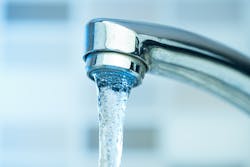Only 15 States and D.C. Have Laws for Testing Lead in School Water
WASHINGTON, D.C. – Only 15 states and the District of Columbia have laws to mandate or encourage lead testing in school water, finds a new white paper released today by the Center for Green Schools at the U.S. Green Building Council (USGBC). The report, “Perspectives on State Legislation Concerning Lead Testing in School Drinking Water,” finds that even among the states with such laws, not all of them require testing or parental notification of all results.
“Access to safe drinking water is a fundamental human right, and every school that has not been tested could potentially be exposing students to contaminated water and the risk of adverse health effects,” said Anisa Heming, director of the Center for Green Schools. “Schools and school district leaders should be able to inform parents about whether drinking water outlets have been tested. Unfortunately, very few states have passed laws ensuring that all schools obtain and provide parents with this critical information. It is important for community stakeholders and parents to advocate to their school board and state representatives to take action.”
The report examines the gap between federal, state and local regulations that results in the majority of schools’ drinking water outlets being left untested. It shows that existing federal laws do not cover the prevention of potential exposure to contaminated drinking water in school buildings, and highlights the urgency for states to mitigate this risk. States can take action to protect children from exposure to lead in school drinking water in a number of ways—through laws, regulations and administrative policies. The report focuses on state laws because they are considered more durable and more likely to be followed and enforced.
State laws that address lead testing in school drinking water are very new; the earliest law was enacted in Ohio in 2016 and the most recent was enacted in Pennsylvania in 2018. Although the current body of public information is limited and nascent, the report draws conclusions about the effectiveness of current laws to inform future legislation. Unsurprisingly, the report found that laws were most effective when requirements for compliance were in place, such as those passed in California and New York. State laws also vary widely on setting a contamination level to trigger necessary remediation.
A 2018 survey by the U.S. Government Accountability Office found that only 43 percent of school districts had tested water outlets for lead.
In the U.S., there are 151,000 public water systems responsible for most water sources, treatment and distribution. Lead contamination, however, can occur at many points between a distribution system and the student ultimately drinking the water. As a result of the existing federal regulatory framework, without state action – whether administrative or legislative – many schools will not be tested.
Though significant work has been done to prevent lead exposure in certain states and Washington D.C., the vast majority of public schools in the U.S. are not required to test for lead in drinking water, the first step in protecting students from potential risk. The U.S. Environmental Protection Agency has issued guidance for reducing lead exposure in schools, but it is voluntary. The lack of public information and the risk to children is also widespread. A 2018 survey by the U.S. Government Accountability Office found that only 43 percent of school districts had tested water outlets for lead, while 41 percent of districts had not tested, and the remaining 16 percent did not know whether or not they had tested.
Lead contamination crises in Michigan and elsewhere in the U.S. in recent years have shed light on the health hazards that can affect nearly every functional system in the body, especially brain development in children. Lead is a colorless, odorless neurotoxin that can contaminate water at any point between distribution and a child ingesting water—in service lines, building pipes and fittings, sink fixtures, etc. Other sources of lead contamination include dust and soil that have been contaminated by paint or particular matter.
In compiling the report, the Center reviewed enacted state laws regarding lead testing in school drinking water, looking at effectiveness through four lenses: testing coverage, testing implementation, risk reduction and disclosure of testing data. It also reviewed published reports on testing data and interviewed stakeholders and agency officials for local perspectives on the effectiveness of these laws.
